Have you ever visited a garden and seen a fence covered with beautiful honeysuckle vines? If so, then you know how attractive this planting option can be. The good news is there’s little stopping you from achieving this look in your own yard. This article will give you all the info you need to be successful. Read on to find out how to grow honeysuckle on a fence.

4 Quick Steps to Help You Grow Honeysuckle on a Fence
Growing a honeysuckle vine is not as difficult as you might expect. In fact, we’ve managed to boil the process down into a few easy-to-remember steps.
Choose the Right Fence for Your Honeysuckle
As you might guess, the first thing you need to grow a honeysuckle vine on a fence is the fence itself. Fortunately, there are many types of fences and other support structures on which you can grow this species.
Honeysuckle plants have strong tendrils that they use to attach to trees, fences, and any other item that can provide the support they need. These tendrils also allow honeysuckle vines to grow on trellises, arbors, lattice structures, and much more. As such, you can be creative in choosing which type of fence you want to grow your honeysuckle on.
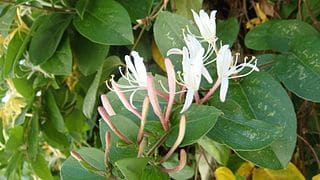
Our only suggestion when selecting a fence for your honeysuckle is to be sure that you want your honeysuckle to grow there. Once mature honeysuckle takes hold of a support structure, it can be quite difficult to remove it.
Remove Existing Vegetation from the Area
The chances are that there is already vegetation growing in the area where you wish to grow your honeysuckle vine. If that is the case, then you should remove most of those existing plants.
Removing existing plants gives your honeysuckle plant plenty of adjacent space into which it can expand. It also prevents too much competition between your plants in the future.
Honeysuckle plants can easily expand and begin to crowd other plants, often to the point where those plants no longer receive the amounts of sunlight and soil nutrients that they need to continue healthy growth. Removing existing plants is one of the best ways to ensure this problem does not arise in your garden in a few years.

Plant Your Honeysuckle the Right Way
The way you plant your honeysuckle vine is as important as any other part of the process. Begin by observing the height and width of your honeysuckle’s rootball. These dimensions will be a helpful guide when deciding how large your planting hole should be.
In nearly all cases, the planting hole you dig should be about as deep as the rootball is tall and about twice as wide. Matching the depth of the hole to the height of the rootball ensures that you won’t plant it too deeply. The double width of your planting hole gives the roots a better chance of spreading horizontally through the soil rather than encircling one another.
Since you’ll be growing your honeysuckle on a fence, you’ll want to pay close attention to the location of your planting hole. As you would guess, you need to locate the hole close enough to the fence so that your honeysuckle can reach it. A honeysuckle that cannot reach its intended support structure will likely spread and grow as a ground cover rather than climbing as you desire.
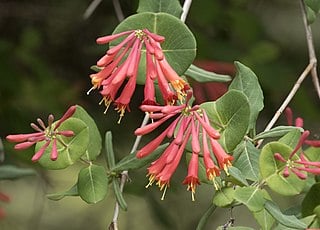
Train Your Honeysuckle to Grow Where You Want
Whenever you wish to grow a climbing plant species on a fence or trellis, you may need to train that plant to expand based on that goal. Training honeysuckle to climb a fence means nothing more than encouraging the plant to grow in one direction rather than another.
One of the easiest ways to train a vine is to physically tie it to the support structure you want it to climb. A string is one of the best materials you can use. Anything that is somewhat soft should work well too.
While training a vine, you should not only use soft materials, but you should also tie the plant somewhat loosely. Tying the plant too tight or using a sharp or abrasive material will damage your honeysuckle and diminish its future growth.
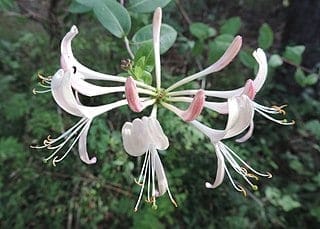
Using a soft material also makes it easier to remove the tie when the time comes. When you notice your honeysuckle is actively attaching itself to the fence and climbing as you intend, you can feel free to remove the ties and allow the plant to continue climbing on its own.
Honeysuckle Growth Requirements
Regardless of whether you choose to grow your honeysuckle on a fence or not, you must know the specific growth requirements for these plants if you want to be successful. The sections below will introduce you to a few of the essential needs of a honeysuckle plant.
Where Does Honeysuckle Vine Grow?
Before you deal with the details of your growing location, you need to make sure that a honeysuckle plant can survive in your region. Typically, most honeysuckle plants survive in hardiness zones 5 through 9. However, there are many honeysuckle varieties, each of which may adapt to a slightly different growing range.
If you search for specific types of honeysuckle, you’ll also find that there are many different species that come from several areas of the world. Within those species are numerous examples that are native species to North America as well as other continents worldwide. The best approach is to select a honeysuckle species that is native to your area. If there isn’t one, then choose one that will survive the temperatures where you live.
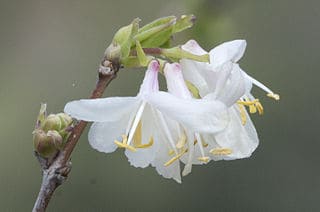
Sunlight Requirements for Honeysuckle Vines
Sunlight is critical for a honeysuckle plant. In nearly all cases, these vines enjoy growing in full sunlight conditions. You should plant them where they will receive at least six hours of direct sunlight each day.
The full sun settings that honeysuckle plants love help this plant produce vigorous new growth. Ample sunlight also encourages honeysuckle vines to develop better quality blooms in higher quantities.
Ideal Soil Conditions for Honeysuckle
Soil conditions are also a crucial aspect when growing any kind of plant in your garden. Honeysuckle vines grow best in soils that have plenty of organic matter. A good balance of moisture retention and drainage capabilities is also important.
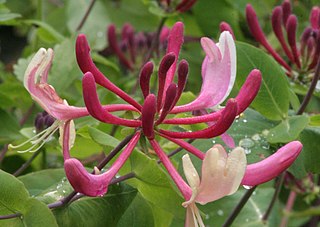
Honeysuckle plants also tend to perform better in soils that are somewhat acidic. They can thrive in soils with pH levels as low as 5.5. However, honeysuckle can also live in soils that are slightly acidic as well.
Ongoing Care for Honeysuckle Growing on Fences
Understanding the growth requirements of a honeysuckle plant and how to plant requires a lot of learning and work. However, even if you do both those tasks with success, your work does not end there.
After planting your honeysuckle, you need to begin an ongoing care routine to help your plant live its best life. Without such a routine, your plant will not have a great chance of becoming as attractive as you might hope.
Thankfully, caring for honeysuckle is not all that hard to do. The next few sections will give you the insights you need to give your honeysuckle plant the attention it deserves.
Watering Needs for Honeysuckle Vines
It’s important to always keep the soil around your honeysuckle moist. However, this does not mean that the soil should be entirely wet. Both waterlogged and excessively dry soils can be detrimental to a honeysuckle vine.
The structure of the soil will play a major role in how well it retains and drains water. The best soil will allow for adequate drainage while holding just enough water to keep the soil moist. This will allow the roots to absorb the water they need.
Your watering schedule is the other main influence over your honeysuckle’s soil moisture. As a rule of thumb, you can start by watering your honeysuckle about once per week during the growing season.
However, when a honeysuckle is young, you may need to water more frequently until it has become established. After establishment, water needs tend to decline for a honeysuckle. Adding a layer of mulch can help as well as that layer will retain soil moisture, making it more readily available to your plant.
FURTHER READING
- How to Plant an Orchid on a Tree
- 9 Native Grasses for Gardeners in Southern California
- How and Why to Create a Pollinator Garden to Attract Bees
How to Fertilize a Honeysuckle Vine
Fertilization for a honeysuckle vine is a straightforward matter. Apply a fertilizer that contains equal amounts of nitrogen, phosphorus, and potassium about once or twice per year.
If you choose to do a single fertilization, you can apply it during the late winter or early spring. Fertilization at that time will give your plant plenty of fuel to grow during the coming season.
Recommended Fertilizers for Honeysuckle
Pruning Strategies for Honeysuckle Vines
Pruning is perhaps the most important aspect of honeysuckle maintenance. Honeysuckle plants can grow quite vigorously and may begin to expand beyond the original area you set aside for them. When growing conditions are correct, this issue is even more prevalent. This is why honeysuckle plants can be considered invasive plants.
The good news is that honeysuckle plants tend to respond well to heavy pruning cuts. The key is to conduct those heavy pruning jobs during the winter when the plant is dormant. However, you can also perform light pruning throughout all the growing season.
You can prune honeysuckle to improve its overall form or to simply contain it. This will be necessary to prevent it from overtaking the rest of your yard. During pruning, you should also do your best to remove any part of the plant that is dead, damaged, or diseased. Removing these parts makes it easier for the plant to send its growing energy to other, healthier parts.
A Few Types of Honeysuckle to Grow on a Fence
Now that you know some of the details of how you can grow honeysuckle on a fence, it’s time for you to learn about a few of the honeysuckle varieties that you can choose to grow in your yard.
Interestingly the term “honeysuckle” can refer to one of many plant species. They all typically share similar growth habits and ornamental qualities. Some of the most popular species of honeysuckle are:
- Lonicera sempervirens, trumpet honeysuckle
- Lonicera periclymenum, common honeysuckle
- Lonicera japonica, Japanese honeysuckle
- Lonicera fragrantissima, winter honeysuckle
- Lonicera caprifolium, Italian honeysuckle
That list of honeysuckle varieties could go on as there are hundreds of species that belong to this group. Before planting a honeysuckle, it’s wise to learn which species you have and to match your care routine to the specific needs of that species.
Final Thoughts on How to Grow Honeysuckle on a Fence
A healthy honeysuckle vine growing over a fence is one of the most attractive features you can add to your yard. By following the simple tips we’ve shared in this post, you can have a thriving honeysuckle vine of your very own. Just be sure to give it plenty of sunlight and water, and don’t forget to enjoy those sweet flowers all summer long!

John Haryasz is a freelance writer and landscape designer. In the field of landscape architecture, he has contributed to many successful design projects throughout the country. As a writer, John specializes in creating captivating and informative web content. Through that work, he aims to share his design knowledge and promote engagement with the outdoor world.


![How to Water Indoor Plants [Plant Care 101]](https://wraxly.com/wp-content/uploads/2021/03/How-to-Water-Indoor-Plants-Plant-Care-101-1200-1024x576.webp)

![Growing Plants from Cuttings [A Simple Guide]](https://wraxly.com/wp-content/uploads/2021/03/Growing-Plants-from-Cuttings-A-Simple-Guide-1200-1024x576.webp)